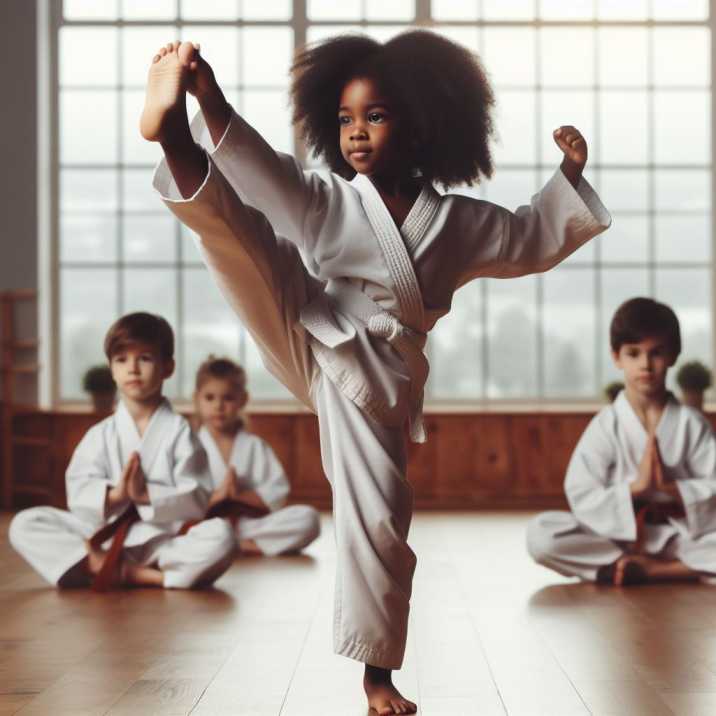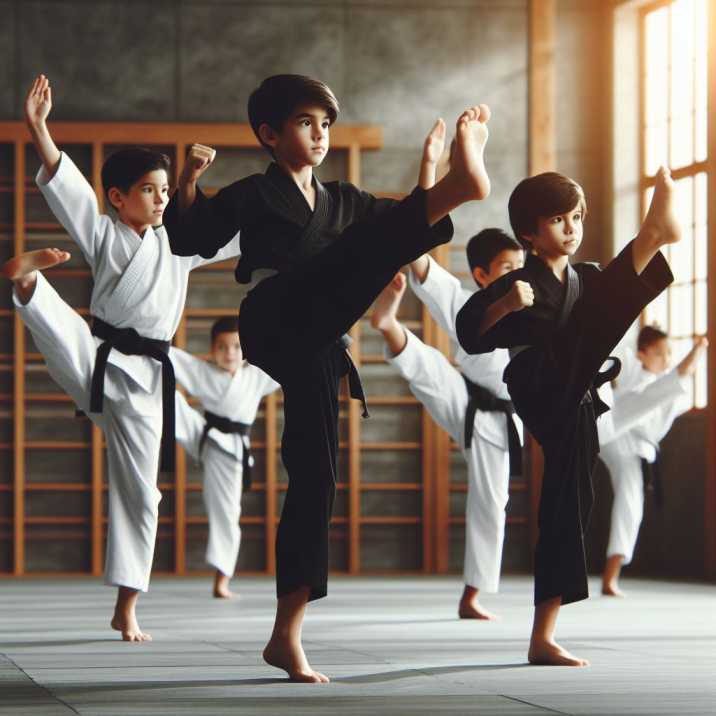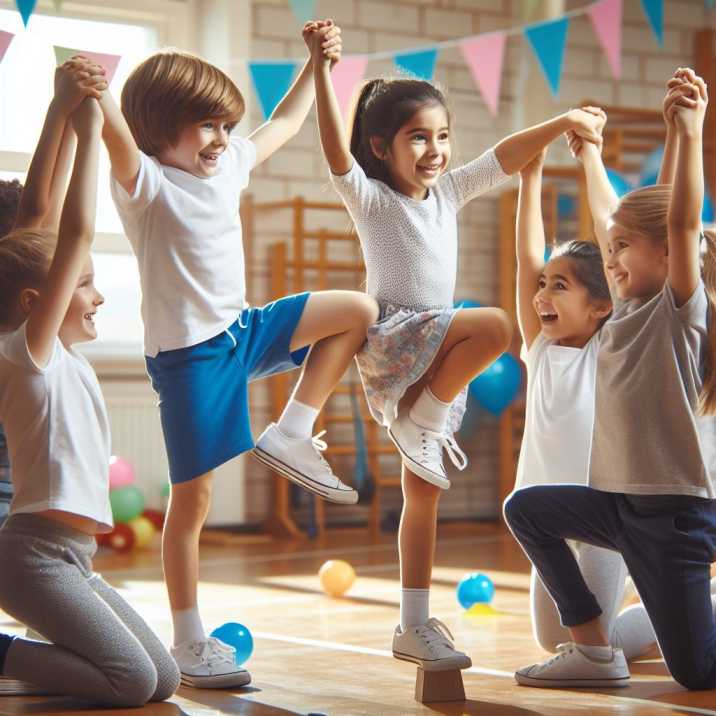Balancing on one leg in kids martial arts.
Table of Contents
Introduction:
In the dynamic world of kids martial arts, the journey of acquiring fundamental skills is both intriguing and essential. One such skill that stands out is “balancing on One leg in kids martial arts.” This article dives into the significance of this skill, exploring its benefits, techniques, and why it’s considered a cornerstone in kids’ martial arts training.

Why Balancing on One Leg Matters:
balancing on One leg in kids martial arts might seem like a simple feat, but in the realm of martial arts for children, it holds profound importance. This skill goes beyond physical coordination; it cultivates discipline, focus, and body awareness.
Benefits of Balancing on One Leg in kids martal arts:
- Enhanced Stability: Balancing on one leg strengthens the core and stabilizes the body, promoting better control during martial arts movements.
- Improved Concentration: Mastering this skill requires focused attention, translating into heightened concentration during martial arts practice and beyond.
- Developing Coordination: Children learn to synchronize body movements, leading to improved overall coordination crucial in martial arts techniques.
- Building Leg Strength: The consistent practice of standing on one leg helps in developing leg muscles, contributing to overall strength and endurance.
Techniques for Balancing on One Leg in kids martial arts:
- Basic Stance: Start with a proper martial arts stance, distributing weight evenly before gradually shifting to balancing on one leg.
- Slow Progression: Begin with short durations and gradually extend the time spent on one leg to avoid strain and ensure a steady learning curve.
- Incorporate Martial Arts Poses: Integrate traditional martial arts poses into one-legged balancing exercises to make the training more dynamic and applicable.

Engagement through Visuals:
To enhance understanding, let’s delve into an information-based table summarizing the benefits and techniques of balancing on one leg in kids martial arts:
| Benefits | Techniques |
|---|---|
| Enhanced Stability | Basic Stance, Slow Progression |
| Improved Concentration | Incorporate Martial Arts Poses |
| Developing Coordination | |
| Building Leg Strength |
This visually appealing table serves as a quick reference guide for parents and instructors, making the information easily accessible.
Balancing on One Leg in Martial Arts Journey:
As children progress in their martial arts journey, the importance of mastering this skill becomes increasingly evident. It becomes the foundation upon which more advanced techniques are built, emphasizing the need for consistent practice and dedication.
Engaging Kids in One-Legged Balancing Activities:
Balancing on one leg in kids martail arts might seem like a challenging task for kids, but with the right approach, it can transform into a fun and rewarding activity. Engaging children in one-legged balancing exercises requires creativity, patience, and an understanding of their developmental stages. Let’s explore some exciting activities to make this fundamental skill an enjoyable part of their balancing on One leg in kids martial arts.
- Balancing Games: Introduce playful games that incorporate one-legged balancing. For example, create a “Balance Beam Adventure” where kids navigate an imaginary path, lifting one leg at a time to avoid obstacles. This not only hones their balancing skills but also sparks their imagination.
- Colorful Props: Make use of colorful props to capture the attention of young martial artists. Place colored markers on the floor and encourage kids to stand on one leg on a specific color. This adds an element of visual engagement, turning a basic exercise into a vibrant experience.
- Animal Balancing Poses: Infuse creativity by associating one-legged balancing with animal poses. Ask kids to mimic the stance of their favorite animals while balancing on one leg. Whether it’s standing tall like a flamingo or crouching low like a tiger, this approach adds an element of playfulness to the practice.
- Partner Activities: Pair kids up for partner activities that involve one-legged balancing. This fosters teamwork and creates a supportive environment. For instance, they can take turns holding hands while balancing, adding an extra layer of coordination and cooperation.
- Storytelling Integration: Weave storytelling into the balancing routine. Create a narrative where kids embark on a martial arts adventure, and each one-legged balance represents a unique challenge or milestone in their journey. This not only keeps them engaged but also helps them connect emotionally with the practice.
- Music and Rhythm: Incorporate music to infuse rhythm into one-legged balancing. Encourage kids to sway and move to the beat while maintaining their balance. This rhythmic approach not only makes the activity more enjoyable but also enhances their sense of timing and coordination.
- Obstacle Courses: Design mini obstacle courses that incorporate one-legged balancing challenges. Use cones, hurdles, and other age-appropriate props to create a course that encourages kids to navigate while balancing on one leg. This adds an element of excitement and adventure to the practice.
- Creative Rewards: Implement a reward system to motivate kids. Set achievable goals and celebrate their progress with small rewards. This could be as simple as earning a colorful sticker for mastering a new one-legged balancing pose. Positive reinforcement fosters a sense of accomplishment.
- Incorporate Martial Arts Forms: Introduce basic martial arts forms that involve one-legged balancing. Teach them age-appropriate forms that integrate balance into kicks, punches, or stances. This not only enhances their martial arts skills but also adds a sense of authenticity to their practice.
- Balancing Challenges: Organize friendly balancing challenges within the group. Create a friendly atmosphere where kids cheer each other on as they attempt different balancing poses. This not only promotes healthy competition but also builds camaraderie among the young martial artists.

Conclusion:
In conclusion, “balancing on One leg in kids martial arts” emerges as a fundamental skill in kids martial arts, providing a solid foundation for physical and mental development. As parents and instructors guide young practitioners through this journey, they contribute not only to their martial arts proficiency but also to their overall growth.
FAQs:
- Q: Why is balancing on one leg important in kids martial arts? A: Balancing on one leg enhances stability, concentration, coordination, and leg strength, forming the basis for advanced martial arts techniques.
- Q: When should children start practicing balancing on one leg? A: Children can begin practicing this skill around the age of 5, gradually progressing as they grow.
- Q: How can parents encourage their kids to practice balancing on one leg at home? A: Incorporate fun activities, set short goals, and practice together to make it an enjoyable experience.
- Q: Are there any risks associated with one-legged balancing exercises for kids? A: When done with proper supervision and progression, the risks are minimal. It’s crucial to ensure a safe environment.
- Q: Can balancing on one leg improve a child’s focus in other areas of life? A: Yes, the concentration required in balancing transfers to improved focus in academics and daily activities.
- Q: Are there specific martial arts styles that emphasize one-legged balancing? A: Many traditional martial arts styles, such as karate and kung fu, incorporate one-legged balancing as a foundational element.
- Q: How often should children practice balancing on one leg? A: Regular practice, 2-3 times a week, is recommended for steady progress without strain.
- Q: Can adults benefit from practicing one-legged balancing exercises too? A: Absolutely! One-legged balancing exercises are beneficial for individuals of all ages, promoting overall stability and strength.
- Q: What role does breathing play in maintaining balance on one leg? A: Controlled breathing enhances focus and stability during one-legged balancing exercises.
- Q: How can instructors make one-legged balancing activities engaging for kids? A: Incorporate games, use colorful props, and create a positive and supportive environment to keep children motivated.
- Q: Is there a progression from basic one-legged balancing to more advanced techniques? A: Yes, as children master the basics, instructors introduce variations and more complex poses to challenge and enhance their skills.
- Q: Can one-legged balancing exercises be adapted for kids with special needs? A: Yes, with modifications and support, these exercises can be adapted to accommodate various abilities and needs.


